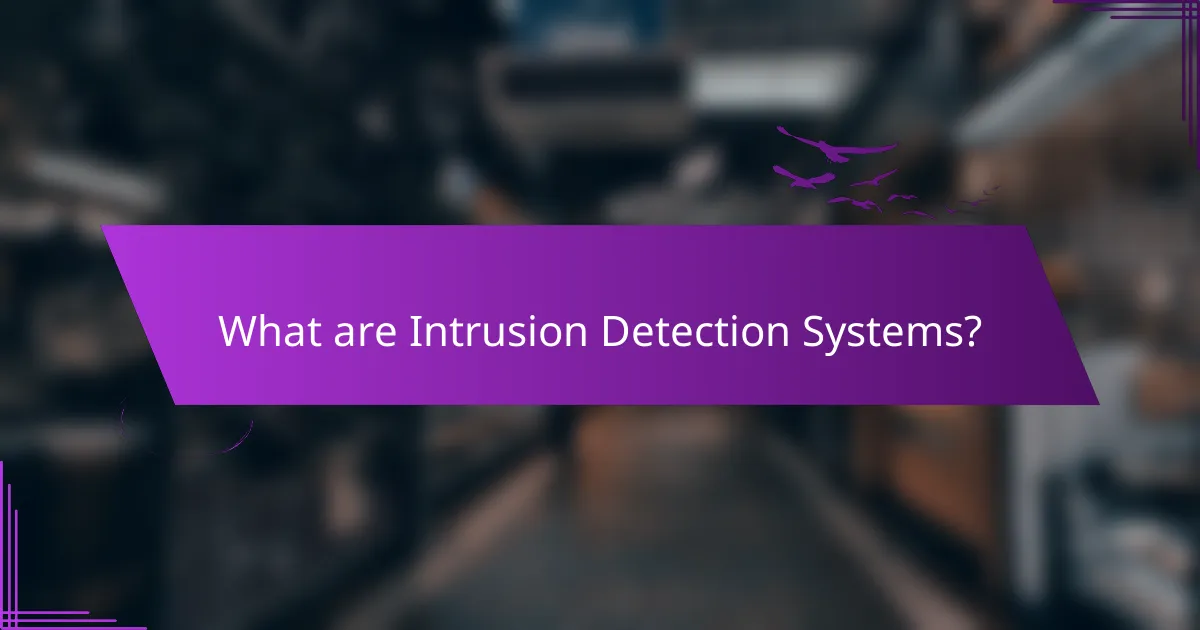
What are Intrusion Detection Systems?
Intrusion Detection Systems (IDS) are security tools designed to monitor network traffic for suspicious activity. They analyze data packets to detect potential threats and unauthorized access attempts. IDS can be classified into two main types: network-based and host-based systems. Network-based IDS monitor traffic across the entire network, while host-based IDS focus on individual devices. These systems use various detection methods, including signature-based and anomaly-based detection. Signature-based detection relies on known threat signatures, while anomaly-based detection identifies deviations from normal behavior. According to the Cybersecurity & Infrastructure Security Agency (CISA), IDS play a critical role in enhancing network security by providing alerts on potential intrusions.
How do Intrusion Detection Systems operate?
Intrusion Detection Systems (IDS) operate by monitoring network traffic for suspicious activities. They analyze data packets and compare them against known attack signatures. IDS can be classified into two main types: network-based and host-based systems. Network-based IDS examines traffic across the entire network, while host-based IDS focuses on individual devices.
When an anomaly is detected, the system generates alerts for network administrators. This immediate response helps in mitigating potential threats. IDS can also utilize machine learning algorithms to improve detection accuracy over time. According to a 2021 study by the Ponemon Institute, organizations using IDS reported a 30% reduction in security incident response times.
What are the key components of Intrusion Detection Systems?
The key components of Intrusion Detection Systems (IDS) include sensors, analysis engines, and user interfaces. Sensors collect data from network traffic or system logs. This data is then processed by analysis engines to identify potential threats. Analysis can be signature-based, anomaly-based, or stateful protocol analysis. User interfaces allow administrators to view alerts and manage the system. These components work together to provide real-time monitoring and threat detection. According to a study by the National Institute of Standards and Technology, effective IDS implementations rely on these core components for accurate threat identification and response.
How do these components interact to detect intrusions?
Intrusion detection systems (IDS) utilize various components to monitor and analyze network traffic for suspicious activity. These components include sensors, analysis engines, and alerting mechanisms. Sensors capture data packets traversing the network. They relay this information to the analysis engine for examination. The analysis engine applies predefined rules and algorithms to identify anomalies or known attack patterns. Once an intrusion is detected, the alerting mechanism generates notifications for system administrators. This interaction allows for real-time monitoring and rapid response to potential threats. The effectiveness of this interaction is supported by the ability of IDS to analyze vast amounts of data efficiently.
What types of Intrusion Detection Systems are available?
There are two main types of Intrusion Detection Systems (IDS): network-based and host-based. Network-based IDS monitor network traffic for suspicious activity. They analyze data packets traveling across the network. Host-based IDS, on the other hand, monitor individual devices for signs of intrusion. They track system calls, file modifications, and other local activities. Both types can detect unauthorized access and policy violations. Their effectiveness is supported by the ability to generate alerts for potential threats. This dual approach enhances security by providing comprehensive coverage of both network and host environments.
What distinguishes network-based Intrusion Detection Systems from host-based systems?
Network-based Intrusion Detection Systems (NIDS) monitor network traffic for suspicious activities. They analyze data packets flowing through the network. Host-based Intrusion Detection Systems (HIDS) monitor individual devices for security breaches. HIDS examines system logs and file integrity on the host itself.
NIDS can detect attacks across multiple devices and systems simultaneously. They are effective in identifying network-wide threats. HIDS, however, focuses on the security of a specific host. They can detect internal threats that may not traverse the network.
The deployment of NIDS typically occurs at strategic points within the network. This allows for comprehensive traffic analysis. In contrast, HIDS is installed on individual devices, providing localized monitoring.
According to a study by Alazab et al. (2019), NIDS can identify broader attack patterns. HIDS is more effective at detecting anomalies on specific systems. This distinction highlights the complementary roles of both systems in cybersecurity.
How do signature-based and anomaly-based detection methods differ?
Signature-based detection methods identify threats by comparing incoming data against a database of known signatures. This approach relies on predefined patterns of malicious activity. It is effective for detecting known threats but struggles with new or unknown attacks. Anomaly-based detection methods, on the other hand, establish a baseline of normal behavior and flag deviations from this norm. This allows for the identification of previously unknown threats. Anomaly-based systems can adapt to new threats but may generate false positives due to benign anomalies. Overall, the key difference lies in signature-based methods’ reliance on known threats, while anomaly-based methods focus on behavioral deviations.

What benefits do Intrusion Detection Systems provide?
Intrusion Detection Systems (IDS) provide enhanced security for networks and systems. They monitor network traffic for suspicious activity. IDS can detect and alert on potential threats in real-time. This rapid response helps mitigate risks before they escalate. They also assist in compliance with regulatory requirements. Many organizations use IDS to fulfill security policies. Additionally, IDS can provide valuable forensic data after a security incident. This data aids in understanding the attack and improving future defenses.
How do Intrusion Detection Systems enhance security?
Intrusion Detection Systems (IDS) enhance security by monitoring network traffic for suspicious activity. They analyze data packets to identify potential threats. IDS can detect unauthorized access attempts and policy violations. They provide real-time alerts to security personnel. This immediate response helps mitigate risks effectively. According to a report by the Ponemon Institute, organizations using IDS reduce incident response time by 30%. Additionally, IDS can log activities for forensic analysis. This historical data aids in understanding attack patterns and improving defenses. Overall, IDS are crucial in maintaining a secure network environment.
What role do Intrusion Detection Systems play in threat detection?
Intrusion Detection Systems (IDS) play a critical role in threat detection by monitoring network traffic for suspicious activities. They analyze data packets to identify potential security breaches. IDS can be categorized into two types: network-based and host-based. Network-based IDS examines traffic across the entire network. Host-based IDS focuses on individual devices or hosts.
These systems utilize various detection methods, including signature-based and anomaly-based detection. Signature-based detection looks for known attack patterns. Anomaly-based detection identifies deviations from established baselines of normal behavior.
Research indicates that organizations employing IDS significantly reduce the risk of data breaches. A report by Verizon found that 81% of breaches involved stolen credentials, highlighting the need for effective detection systems. Thus, IDS serves as a vital component in an organization’s cybersecurity strategy, enhancing overall threat detection capabilities.
How can Intrusion Detection Systems help in compliance with regulations?
Intrusion Detection Systems (IDS) assist in compliance with regulations by continuously monitoring network traffic for unauthorized access. They provide real-time alerts for suspicious activities, which helps organizations respond promptly to potential breaches. Compliance frameworks often require organizations to demonstrate effective security measures. IDS can generate logs and reports that document security events, aiding in audit processes. Many regulations, such as GDPR and HIPAA, mandate data protection measures. By identifying vulnerabilities and threats, IDS supports organizations in adhering to these requirements. Regular updates and maintenance of IDS also ensure ongoing compliance with evolving regulations.
Which organizations benefit the most from implementing Intrusion Detection Systems?
Organizations that benefit the most from implementing Intrusion Detection Systems (IDS) include financial institutions, healthcare providers, and government agencies. Financial institutions require robust security due to the sensitive nature of financial data. Healthcare providers must protect patient information to comply with regulations like HIPAA. Government agencies face threats to national security and need to safeguard critical infrastructure. These organizations often experience higher attack rates and require advanced security measures. The implementation of IDS helps detect and respond to potential threats in real-time. This proactive approach reduces the risk of data breaches and enhances overall security posture.
What specific industries see the greatest value from these systems?
The industries that see the greatest value from intrusion detection systems include finance, healthcare, and government. The finance sector relies on these systems to protect sensitive customer data and prevent fraud. Healthcare organizations use them to safeguard patient information and comply with regulations like HIPAA. Government agencies implement intrusion detection to secure national security data and critical infrastructure. According to a report by Cybersecurity Ventures, the global cybersecurity market is projected to reach $300 billion by 2024, highlighting the increasing importance of such systems across various sectors.
How does the size of an organization impact the effectiveness of Intrusion Detection Systems?
The size of an organization significantly impacts the effectiveness of Intrusion Detection Systems (IDS). Larger organizations typically have more complex networks. This complexity can lead to increased vulnerability to cyber threats. Additionally, larger organizations often generate more data traffic. An IDS must process this data efficiently to identify potential intrusions accurately.
Smaller organizations may have simpler networks. Their reduced data traffic can make it easier for IDS to detect anomalies. However, they may lack the resources for advanced IDS implementations. This can lead to less effective monitoring and response capabilities.
Research indicates that organizations with dedicated security teams are more effective in leveraging IDS. According to a study by the Ponemon Institute, organizations with larger IT security budgets report higher IDS effectiveness. Thus, the size of an organization influences both the complexity of its network and the resources available for IDS deployment.

What are the deployment methods for Intrusion Detection Systems?
Intrusion Detection Systems (IDS) can be deployed using several methods. The primary deployment methods include network-based, host-based, and hybrid systems.
Network-based IDS monitors network traffic for suspicious activity. This method analyzes data packets traveling across the network. Host-based IDS, on the other hand, is installed on individual devices. It monitors system calls and file modifications on that specific host.
Hybrid IDS combines both network and host-based approaches. This method provides comprehensive coverage by monitoring both network traffic and host activities. Each deployment method has its own strengths and weaknesses.
For example, network-based IDS can detect attacks across multiple devices but may miss host-specific threats. Host-based IDS can identify threats at the device level but may not detect network-wide attacks. Hybrid systems aim to mitigate these limitations by integrating both methods.
These deployment methods are essential for ensuring effective security measures against potential intrusions.
What factors should be considered when deploying an Intrusion Detection System?
Key factors to consider when deploying an Intrusion Detection System (IDS) include network architecture, detection capabilities, and scalability. Network architecture impacts where the IDS should be placed, whether on the network perimeter or within the internal network. Detection capabilities must align with the specific threats the organization faces, such as signature-based or anomaly-based detection. Scalability is crucial to ensure the IDS can grow with the network and adapt to increasing traffic. Additionally, integration with existing security infrastructure is necessary for effective incident response. Compliance requirements may also dictate certain features or reporting capabilities. Finally, the total cost of ownership, including setup and maintenance, should be evaluated to ensure budget alignment.
How does network architecture influence deployment decisions?
Network architecture significantly influences deployment decisions for intrusion detection systems (IDS). The design of the network determines how data flows and where vulnerabilities may exist. Different architectures, such as flat or hierarchical, dictate the placement of IDS components. For instance, a flat architecture may require more sensors to cover the entire network, while a hierarchical structure can optimize monitoring through strategic placement.
Additionally, the architecture impacts scalability and performance. A well-designed architecture allows for efficient integration of IDS, supporting future growth without major overhauls. Security policies and compliance requirements are also shaped by the network’s structure, guiding the selection of specific IDS solutions.
Research indicates that 70% of organizations consider network architecture when implementing security measures (Source: Cybersecurity & Infrastructure Security Agency, 2022). Thus, understanding the network architecture is critical for making informed deployment decisions for IDS.
What are the costs associated with deploying an Intrusion Detection System?
The costs associated with deploying an Intrusion Detection System (IDS) include hardware, software, and ongoing maintenance expenses. Hardware costs can range from $1,000 to $50,000, depending on the complexity and scale of the system. Software licensing fees typically range from $500 to $10,000 annually. Additionally, there are costs for installation and configuration, which can vary based on the provider and system requirements. Ongoing maintenance and support can add another 15-20% of the initial investment per year. Organizations should also consider training costs for staff, which can be around $1,000 to $5,000 per employee. Overall, the total cost can vary widely, often exceeding $100,000 for larger enterprises.
What are the best practices for maintaining an Intrusion Detection System?
Regular updates to the Intrusion Detection System (IDS) are essential for effective maintenance. This includes updating signatures and rules to recognize new threats. Continuous monitoring of system logs is necessary to identify unusual patterns. Implementing alert thresholds helps in prioritizing responses to potential threats. Regularly testing the IDS through simulated attacks can reveal vulnerabilities. Documenting changes and incidents aids in tracking system performance over time. Training personnel on the latest security practices enhances overall system effectiveness. According to a 2021 study by the National Institute of Standards and Technology, consistent maintenance practices significantly reduce the risk of security breaches.
How can organizations ensure their Intrusion Detection Systems remain effective over time?
Organizations can ensure their Intrusion Detection Systems (IDS) remain effective over time by regularly updating their detection signatures and algorithms. Continuous updates help the IDS recognize new threats and vulnerabilities. Conducting routine system audits is crucial for identifying any weaknesses or outdated configurations. Training staff on the latest security practices enhances the overall effectiveness of the IDS.
Implementing a robust incident response plan allows organizations to react swiftly to detected threats. Regularly reviewing logs and alerts ensures that any anomalies are promptly addressed. Additionally, integrating the IDS with other security systems provides a comprehensive defense strategy. According to a report by the Ponemon Institute, organizations that maintain updated security measures reduce their risk of data breaches significantly.
What common troubleshooting steps should be taken for Intrusion Detection Systems?
Common troubleshooting steps for Intrusion Detection Systems (IDS) include verifying system configurations. Check for proper network settings and ensure all components are correctly integrated. Review logs for error messages or alerts that indicate issues. Confirm that the IDS has the latest updates and signatures installed. Test the system’s response to simulated threats to validate functionality. Restart the IDS to resolve temporary glitches. Ensure that network traffic is flowing correctly and not being blocked. Finally, consult vendor documentation for specific troubleshooting guidance.
Intrusion Detection Systems (IDS) are crucial security tools that monitor network traffic for suspicious activities and potential threats. This article explores the functionality of IDS, detailing their types—network-based and host-based—along with the detection methods used, such as signature-based and anomaly-based detection. Key components, deployment methods, and the factors influencing their effectiveness are examined, alongside the benefits they provide in enhancing security and ensuring regulatory compliance. Additionally, the article highlights best practices for maintaining IDS and common troubleshooting steps to ensure their optimal performance.
